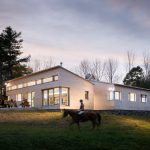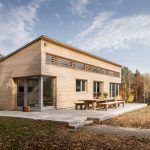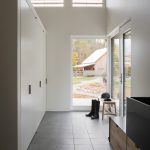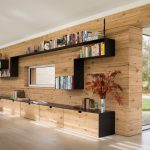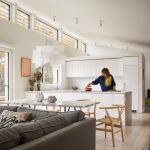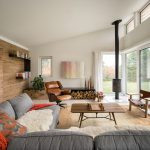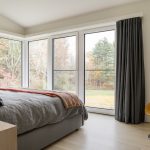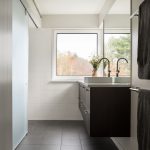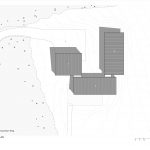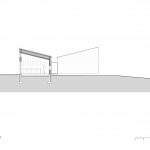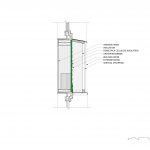Maine Rural Modern
Project Name
Designed for an active, outdoor-oriented couple, Maine Rural Modern stands on 10 acres of gently rolling pasture ringed by mixed woodland, a property it shares with a four-stall horse barn. Reflecting both the character of the setting and its owners’ appreciation for contemporary architecture, the design applies modernist rigor—and Passive House principles of building performance—to the simple forms and rugged materials of the agricultural vernacular. The result is a space- and energy-efficient house that matches practicality with architectural clarity.
To preserve open outdoor space, the house hugs the property’s wooded northern boundary, facing south toward the barn and a wood-fenced paddock. The graveled main driveway brings guests to a casual dooryard at the front of the house, while an unobtrusive spur drive swings around to the rear, keeping the garage entrance and the owners’ parking area out of sight.
The building consists of three shed-roofed wings—one for living spaces, one for the three bedrooms, and one for the garage—separated by two glass-walled links. The forms are clean and contemporary, but their rustic exterior materials—cedar siding, fieldstone-faced foundations, and steel roofing—reflect the rural setting and the roughness of the adjacent barn. The foot-thick walls necessary for Passive House-level thermal insulation are evident at the deep window and door openings, lending a reassuring sense of shelter. An apron of local granite pavers spreads out to the south, creating both an entry sequence and an outdoor dining space.
Inside, the house’s single-level floor plan is a model of modernist clarity, with each wing mapping onto a different set of functions. The long main wing stretches from east to west, encompassing the entry and a combined kitchen, dining, and living space. A high wall at the south opens toward views of the barn and paddock, and to capture the solar gain that provides much of the building’s heat. A band of clerestory glazing is shaded by a slatted cedar screen that blocks unwanted summer sun while admitting lower-angle winter rays.
The bedroom wing projects toward the north from the living area. Its single-loaded corridor is located under the high side of wing’s shed roof, which gives it a height proportional to that of the living areas; a floor-to-ceiling door closes off the corridor for privacy at the master suite. The master bedroom and two guest bedrooms face east, toward the morning sun and views of the field and woods. The guest bath includes a laundry closet, hidden behind a sliding barn door, and is convenient enough to the living spaces to obviate the need for a separate powder room. The garage wing is located at the building’s northwest corner, where it opens into the main entry.
A simple palette of interior finishes reinforces the floor plan’s schematic simplicity, with white walls and ceilings backdropping every room. Flush-front white cabinetry and white marble countertops give the kitchen a bright, clean look that doesn’t distract attention from the dining and living areas. The accent, instead, is on the main wing’s north wall, which is paneled with reclaimed oak boards. Detailed with blackened steel shelving and oak-and-steel storage benches that wrap into the living room and entry, this strong visual spine unifies the multifunction space. Atop the entryway bench rests a handsome black granite utility sink.
Like all OPAL buildings, Maine Rural Modern follows the Passive House model of energy efficiency and indoor air quality, so its mechanical equipment consists primarily of a central heat-recovery ventilation system, a heat pump domestic water heater, and small electric baseboard heating units. A wood stove provides ambiance, and an alternative heat source. Thanks to the super insulated building shell, high-performance triple-glazed windows and doors, and meticulous air-sealing, though, most of the space heating not supplied by the sun comes from incidental sources like the refrigerator and television—and from the occupants themselves.
Measure 1: Design for Integration
Maine Rural Modern occupies a 10-acre site buffered from neighboring properties by topography and vegetation. Given this high degree of privacy, the building takes its cues from the site—a forest-ringed pasture with a horse barn—and its program as a retirement residence that would also serve as an outdoor-recreation hub for a three-generation extended family. The design applies a modernist aesthetic—and Passive House principles of energy efficiency and indoor air quality—using vernacular building forms and rugged local materials. A gravel drive that hugs the wooded margin of the property and a rear-entry garage that conceals cars from the main outdoor space, preserve the site’s agrarian character and sense of remove.
Measure 2: Design for Community
While physically distant from its immediate neighbors, the project fosters a sense of community among the extended-family members who use it on a daily basis, and who participated actively in its design. By supporting healthy, meaningful, physically challenging outdoor activities, it encourages personal development and intergenerational bonds. The rural location entails car transportation for most off-site errands, but the property itself is a center of carbon-neutral activity.
Measure 3: Design for Ecology
The building’s siting and its engagement with the site’s natural contours minimized disturbance to the existing topography and vegetation. Landscaping is minimal, consisting largely of native woodland species and meadow grasses that require minimal inputs of energy and water. The presence of the buildings will have negligible impact on the site’s potential as wildlife habitat. Reusing existing driveways reduced the extent of site disturbance.
Measure 4: Design for Water
The project preserved all existing natural water flows on the site without disturbance. A relatively compact building form and minimal paved surfaces support the site’s capacity to manage rainwater and slow runoff.
Measure 5: Design for Economy
The project optimizes cost performance by making efficient use of space and by using durable, low-maintenance materials. The high performance building shell, including triple-glazed windows and doors and heat-recovery ventilation, reduces annual energy cost by approximately 80 percent, compared with conventional, code-compliant construction.
Measure 6: Design for Energy
The building was designed and sited to optimize passive solar gain. It incorporates an air-sealed Passive House building shell with R-50 walls and an R-80 roof, an energy efficient HRV system, and high-efficiency lighting and mechanical systems. A high-efficiency, sealed-combustion wood stove produces the majority of the house’s active space heating, burning firewood cut on site. Several small electric resistance baseboard units supply backup heat. Shading and passive cooling keep the house comfortable on the hottest summer days. Domestic hot water is supplied with a heat pump water heater.
Measure 7: Design for Wellness
The Passive House building shell maintains a stable and uniform temperature with minimal supplemental heating, providing a high degree of thermal comfort. Continuous, tempered, filtered ventilation maximizes indoor air quality. Fenestration provides ample, balanced daylighting, while minimizing harsh, low-angle sunlight. Materials and finishes were selected, to the greatest degree possible, to minimize VOC content throughout. Strong indoor-outdoor connections encourage physical activity through engagement with the barn, horses, and natural surroundings.
Measure 8: Design for Resources
The building makes use of reclaimed oak paneling and cellulose insulation manufactured from recycled paper. The white cedar siding is a sustainably produced local product that requires no finish over its lifespan. Locally quarried granite tops the patio; the foundation walls are faced with fieldstone gathered from the site. The standing-seam metal roofing is maintenance free, has a long service life, and is fully recyclable. The aluminum-clad windows and doors are prefinished and require no finish maintenance.
Measure 9: Design for Change
The Passive House building shell affords a high degree of resilience to environmental stress or shock. In the event of an extended power outage, the building temperature will stabilize at far above freezing, remain habitable in reasonable comfort, and survive indefinitely without damage to its structure or systems. Drainage-plane construction detailing and multiple layers of weatherproofing allow the exterior walls sustain wetting and drying cycles without damage or performance degradation.
Measure 10: Design for Discovery
In its design process and its ongoing use, this project explores an evolving conception of retirement, one that includes active, four-season outdoor living, plentiful extended-family interaction, and sharing work, play, and respect for the environment across generations.

